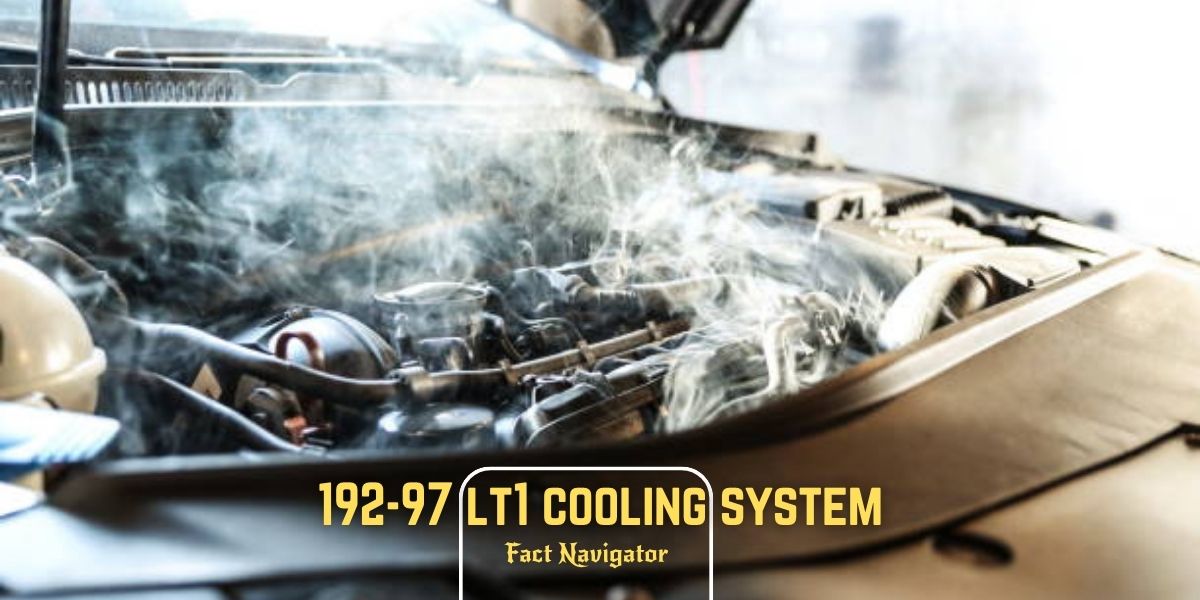Master Your 192-97 LT1 Cooling System: A Comprehensive Guide

The 192-97 lt1 engine, renowned for its power and performance, demands meticulous care to ensure optimal operation. One crucial aspect often overlooked is the cooling system. A well-maintained cooling system is vital for preventing overheating, which can lead to severe engine damage. This comprehensive guide will delve into the intricacies of the 192-97 lt1 cooling system, empowering you to understand its components, troubleshoot common issues, and maximize your engine’s lifespan.
By understanding the 192-97 lt1 cooling system, you can proactively address potential problems, preventing costly repairs and ensuring your engine runs at its peak efficiency. This guide will equip you with the knowledge and tools to maintain a healthy cooling system, allowing you to enjoy the full potential of your LT1 engine.
Contents [hide]
192-97 lt1 cooling system: Understanding Its Vital Components
The 192-97 lt1 cooling system is a complex network of components working in harmony to regulate engine temperature and prevent overheating. Let’s explore the key components that play a crucial role in maintaining optimal engine performance:
The Radiator: The Heart of the Cooling System
The radiator is the cornerstone of the 192-97 lt1 cooling system. It’s responsible for dissipating excess heat from the engine coolant into the surrounding air. Located at the front of the vehicle, the radiator typically consists of a network of tubes and fins that facilitate heat transfer.
Signs of a Failing Radiator:
- Coolant Leaks: Look for puddles of coolant beneath your vehicle, particularly after parking.
- Corrosion: Inspect the radiator for signs of rust or corrosion, which can compromise its ability to effectively cool the engine.
- Overheating: If your engine frequently overheats, despite proper coolant levels and maintenance, a faulty radiator could be the culprit.
The Water Pump: Circulating the Lifeblood
The water pump is the heart of the cooling system, circulating coolant throughout the engine to absorb heat. It’s a critical component that requires regular maintenance to ensure optimal performance.
Signs of a Failing Water Pump:
- Coolant Leaks: Leaking coolant can indicate a worn-out water pump seal or impeller.
- Unusual Noises: Listen for unusual noises, such as grinding or whining sounds, which could be a sign of a failing water pump.
- Overheating: A faulty water pump can prevent the coolant from circulating effectively, leading to overheating.
The Thermostat: Regulating Engine Temperature
The thermostat acts as a gatekeeper, controlling the flow of coolant through the radiator. It opens and closes to regulate engine temperature and prevent overheating.
Common Thermostat Issues:
- Sticking Open: A stuck-open thermostat can cause the engine to run cold, leading to decreased performance and fuel efficiency.
- Sticking Closed: A stuck-closed thermostat can prevent coolant from flowing through the radiator, causing the engine to overheat.
Coolant Hoses: The Network of Pathways
Coolant hoses connect the various components of the cooling system, allowing coolant to circulate efficiently. These hoses are vital for preventing leaks and ensuring proper coolant flow.
Signs of Deterioration:
- Cracks or Bulges: Inspect hoses for signs of wear and tear, such as cracks or bulges. These can lead to coolant leaks and compromise the cooling system’s integrity.
The Overflow Reservoir: A Safety Net
The overflow reservoir, also known as the coolant recovery tank, serves as a backup reservoir for coolant. It collects excess coolant when the engine is hot and releases it back into the cooling system when it cools down.
Maintaining Proper Coolant Levels:
- Regular Checks: Check the coolant level in the overflow reservoir regularly. The coolant level should be between the “full” and “low” marks.
- Topping Off: If the coolant level is low, add the appropriate type of coolant to the reservoir. Avoid overfilling.
Coolant: The Lifeblood of Your Engine
Using the correct type of coolant is essential for the health of your 192-97 lt1 engine. Consult your owner’s manual for the recommended coolant type and follow the manufacturer’s instructions for proper mixing and maintenance.
Coolant Lifespan and Flushing:
- Regular Flushing: Most coolant types have a recommended lifespan of 2-5 years. Regular flushing and replacement help prevent corrosion and ensure optimal cooling performance.
- Follow Manufacturer Guidelines: Refer to your owner’s manual for specific coolant replacement intervals and flushing procedures.
By understanding the components of the 192-97 lt1 cooling system and addressing potential issues proactively, you can ensure your engine runs smoothly and efficiently.
Troubleshooting the 192-97 lt1 cooling system
A well-functioning cooling system is crucial for the longevity and performance of your 192-97 lt1 engine. Let’s explore common cooling system issues and their potential solutions, empowering you to diagnose and address problems effectively.
Overheating: A Common Concern
Overheating is a serious issue that can lead to engine damage if not addressed promptly. Here are common causes and troubleshooting steps:
- Low Coolant Level: Regularly check the coolant reservoir and ensure it’s filled to the appropriate level. Low coolant can cause overheating due to insufficient cooling capacity.
- Faulty Thermostat: A malfunctioning thermostat can prevent coolant from flowing through the radiator, leading to overheating. If the thermostat is stuck closed, replace it with a new one.
- Clogged Radiator: Over time, the radiator can become clogged with debris, restricting coolant flow and hindering heat dissipation. Have your radiator professionally cleaned or flushed to restore its efficiency.
- Water Pump Malfunction: A faulty water pump can prevent coolant from circulating properly, resulting in overheating. Inspect the water pump for leaks or signs of wear and replace it if necessary.
Coolant Leaks: A Silent Threat
Coolant leaks can lead to low coolant levels and overheating. Identifying the source of a leak is crucial for timely repairs:
- Radiator Leaks: Inspect the radiator for cracks, leaks, or corrosion. If necessary, have the radiator repaired or replaced.
- Hose Leaks: Check all coolant hoses for cracks, bulges, or leaks. Replace any damaged hoses to prevent coolant loss.
- Water Pump Leaks: A leaking water pump can cause coolant to seep out. Inspect the pump for signs of leaks and replace it if necessary.
Temporary Fixes and Permanent Solutions
For minor coolant leaks, a radiator stop leak product might provide a temporary solution. However, it’s essential to address the underlying issue and replace the faulty component for a permanent fix.
Temperature Gauge Fluctuations: Interpreting the Signs
Monitor your vehicle’s temperature gauge to ensure it stays within the normal operating range. Fluctuations outside this range could indicate a problem.
- Faulty Temperature Sensor: A malfunctioning temperature sensor can provide inaccurate readings. Replace the sensor if it’s suspected of being faulty.
- Electrical Issues: Loose connections or wiring problems can affect the temperature gauge’s accuracy. Inspect the wiring and connections for any damage or corrosion.
By understanding these common issues and following the troubleshooting steps, you can effectively address cooling system problems and maintain the optimal performance of your 192-97 lt1 engine.
Preventative Maintenance for Optimal Performance
A well-maintained cooling system is vital for ensuring the longevity and peak performance of your 192-97 lt1 engine. By implementing regular maintenance practices, you can proactively address potential issues and prevent costly repairs.
Scheduled Coolant Flush and Refill: A Vital Task
Coolant plays a crucial role in regulating engine temperature and preventing corrosion. Over time, coolant can become contaminated or lose its effectiveness. Regular flushing and refilling are essential to maintain optimal cooling system performance.
- Consult Your Owner’s Manual: Refer to your vehicle’s owner’s manual for the recommended coolant replacement intervals. These intervals may vary based on driving conditions and the specific coolant type used.
- Professional Flushing: While you can flush the cooling system yourself, it’s often recommended to have it done by a professional mechanic. They have the necessary tools and expertise to ensure complete removal of old coolant and proper refilling with the correct coolant type.
Visual Inspection: A Crucial Step
Regularly inspecting your 192-97 lt1 cooling system for signs of wear and tear is essential. Here are some key areas to focus on:
- Coolant Level: Check the coolant reservoir regularly to ensure the coolant level is within the recommended range. Low coolant levels can lead to overheating.
- Hose Inspection: Examine all coolant hoses for cracks, bulges, or leaks. Replace any damaged hoses promptly to prevent coolant loss.
- Radiator Inspection: Inspect the radiator for signs of corrosion, leaks, or debris. A damaged radiator can compromise the cooling system’s efficiency.
Proactive Component Replacement:
Some components of the cooling system have a limited lifespan. Replacing these components before they fail can prevent unexpected breakdowns and costly repairs.
- Coolant Hoses: Coolant hoses can deteriorate over time due to heat, exposure to chemicals, and general wear and tear. Replace hoses that show signs of cracking or bulging to prevent coolant leaks.
- Thermostat: The thermostat plays a crucial role in regulating engine temperature. If your thermostat is malfunctioning or nearing the end of its lifespan, replace it to ensure proper coolant flow and prevent overheating.
Upgrading the Cooling System: Enhancing Performance
For those seeking improved performance or driving conditions that demand a more robust cooling system, aftermarket upgrades might be considered. However, it’s essential to consult with a mechanic to ensure compatibility and proper installation.
- Performance Radiators: Upgraded radiators with increased cooling capacity can be beneficial for vehicles subjected to heavy loads or extreme temperatures.
- High-Flow Water Pumps: Installing a high-flow water pump can improve coolant circulation and enhance cooling efficiency.
- Coolant Additives: While coolant additives can offer additional protection against corrosion and cavitation, consult your owner’s manual or a mechanic for recommendations.
By prioritizing regular maintenance, visual inspections, and proactive component replacement, you can effectively maintain the health and performance of your 192-97 lt1 cooling system. A well-maintained cooling system will not only prevent overheating but also contribute to the overall longevity and reliability of your vehicle.
A Visual Guide to the 192-97 lt1 cooling system
Understanding the layout and components of the 192-97 lt1 cooling system is essential for effective maintenance and troubleshooting. The following diagram provides a visual representation of the system, highlighting the key components and their interconnections.
Coolant Flow Path:
- Radiator: Coolant enters the radiator from the engine, where it is cooled by the surrounding air.
- Water Pump: The water pump circulates the coolant throughout the system, ensuring proper heat distribution.
- Engine Block: Coolant flows through the engine block, absorbing heat from the combustion process.
- Thermostat: The thermostat regulates the flow of coolant, directing it to the radiator when the engine reaches operating temperature.
- Overflow Reservoir: Excess coolant is stored in the overflow reservoir, ensuring adequate coolant levels.
Replacement Parts and Kits: Ensuring a Smooth Repair
When it comes to repairing or upgrading your 192-97 lt1 cooling system, having access to high-quality replacement parts is crucial. The following components are commonly replaced:
- Radiator: Look for radiators made from durable materials like aluminum or brass, ensuring efficient heat dissipation.
- Water Pump: Opt for a high-quality water pump to ensure reliable coolant circulation.
- Thermostat: Replace the thermostat with a genuine OEM or reputable aftermarket part to maintain proper temperature regulation.
- Coolant Hoses: Choose hoses made from durable materials to prevent leaks and ensure proper coolant flow.
DIY vs. Professional Repair: Weighing Your Options
While some basic maintenance tasks, such as checking coolant levels and replacing hoses, can be handled by DIY enthusiasts, complex repairs like replacing the radiator or water pump are best left to professionals with the necessary tools and expertise.
Reputable Brands and Online Retailers:
When sourcing replacement parts, consider reputable brands known for their quality and reliability. Online retailers often offer a wide selection of parts at competitive prices. Be sure to research and compare options before making a purchase.
By understanding the layout of the 192-97 lt1 cooling system and having access to quality replacement parts, you can effectively maintain and repair your vehicle’s cooling system, ensuring optimal performance and longevity.
Also Read: Storytime Sam asstr.org: Engaging Storytelling for Kids
Conclusion: A Cool Head for a Healthy Engine
The 192-97 lt1 cooling system plays a vital role in ensuring the optimal performance and longevity of your vehicle. By understanding its components, addressing potential issues proactively, and prioritizing regular maintenance, you can maintain a healthy and efficient cooling system.
Key Takeaways:
- The 192-97 lt1 cooling system consists of several essential components, including the radiator, water pump, thermostat, coolant hoses, and overflow reservoir.
- Regular inspections, coolant flushes, and component replacements are crucial for maintaining a healthy cooling system.
- Addressing issues like overheating, coolant leaks, and temperature gauge fluctuations promptly can prevent further damage and costly repairs.
- By following the guidelines outlined in this guide, you can ensure your 192-97 lt1 engine runs smoothly and efficiently.
Do you have any questions about the 192-97 lt1 cooling system or have you encountered specific issues? We encourage you to leave a comment below and share your experiences. Your insights can be valuable to other LT1 owners.
By investing time and effort into maintaining your 192-97 lt1 cooling system, you can enjoy a long and trouble-free driving experience. Remember, a cool head is essential for a healthy engine.






